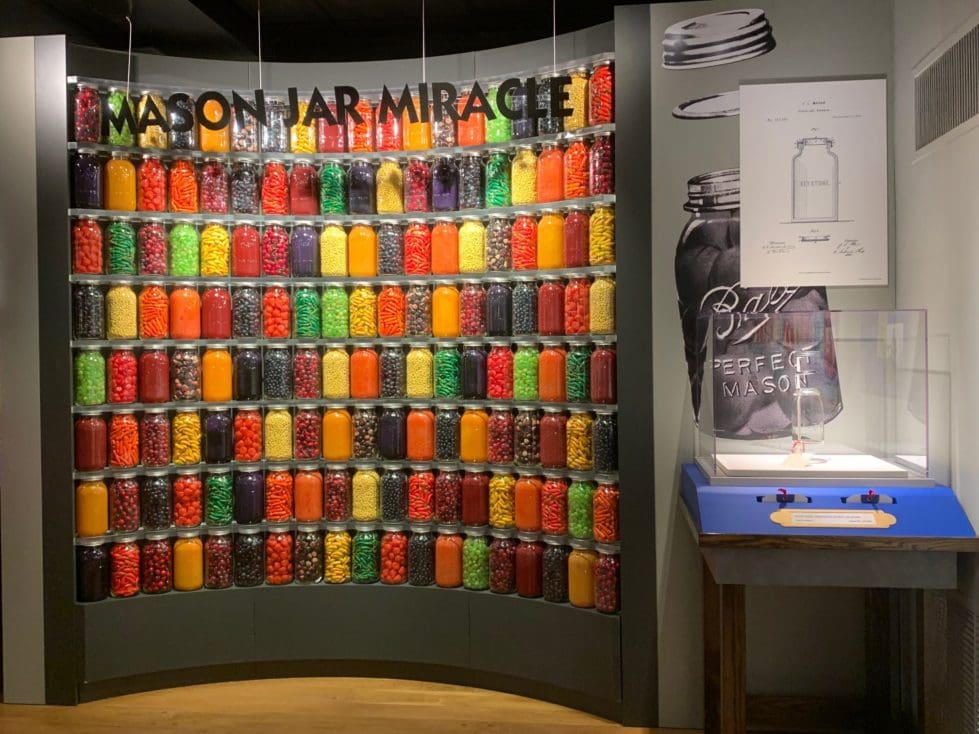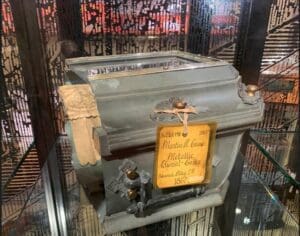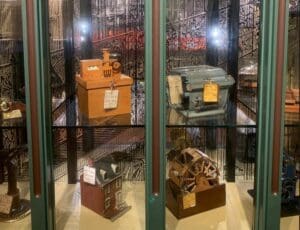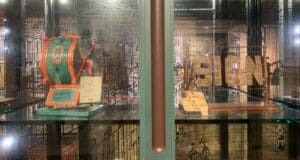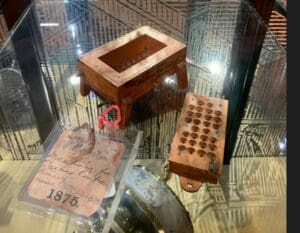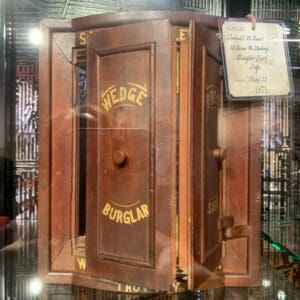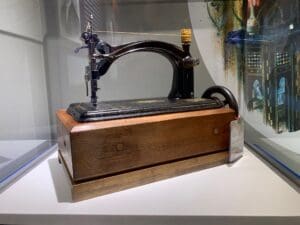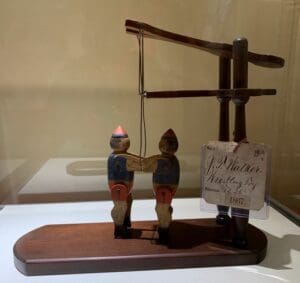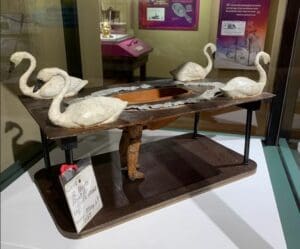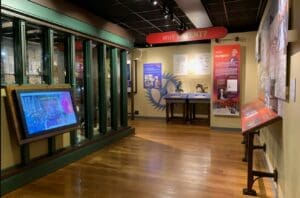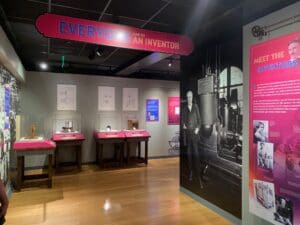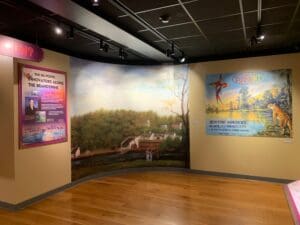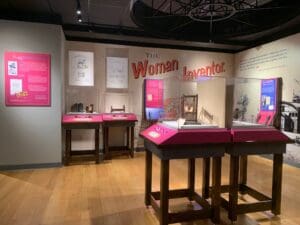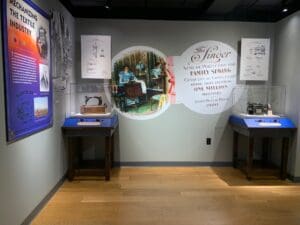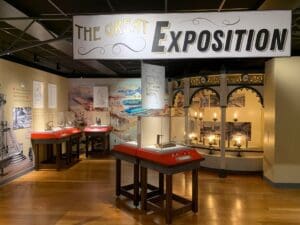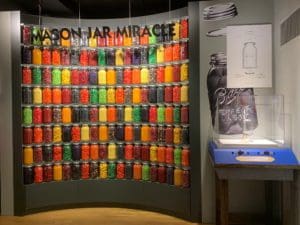
The opening of Hagley ‘Nation of Inventors’ exhibit was delayed after floodwaters did $2 million of damage to the campus’s utility systems.
More than a year after Hagley Museum’s splashy new “Nation of Invent0rs” exhibit was expected to open, it swung the doors wide Saturday.
The showcase, built around the museum’s huge collection of patent models, traces the history of American ingenuity since Colonial days, looking at the contributions of industry, entrepreneurs, immigrants and women.
While the museum is hailing the opening as a homecoming for patent models that have been traveling to be displayed in museums around the world, it’s actually a victory over Mother Nature.
Its September 2021 opening was canceled after the Brandywine River that bounds its property rose a few days before the opening as the remnants of Hurricane Ida came through.
It caused $2 million of damage to the Hagley’s utility infrastructure, much of which was in the basement of the visitors center, where the exhibit is located upstairs. The exhibit was not damaged, but 120 models had to be removed while work was done.
During the year-long reconstruction delays were caused by supply chain issues, and contractors faced the same labor market challenges as other employers.
Hagley’s fame is due to its history as the home to the DuPont Corp.’s first business, gunpowder yards, and the site of the du Pont family’s ancestral home.
During a preview show before the 2021 storm, Hagley’s Executive Director Jill MacKenzie said the mission of the museum and exhibit is to inspire people to be innovative in their own lives, partly by exploring Hagley’s collections, original powder yards and online resources.
“We think that one of the best ways to do that is for them to understand that this is not something that’s new,” she said “People have been inspired to invent for hundreds of years and so coming here and teasing out the stories of the inventors I know is going to inspire them because it certainly inspired me.”
The $2 million exhibit that opened Saturday replaces one about the history of the DuPont Corp. It had been installed in 1957.
Visitors are welcomed by a glass case filled with 60 patent models, culled from the 5,000 that are in Hagley’s collection. Dozens more are scattered throughout the two-story exhibit.
Some are silly, some are profound and some will make you marvel, both at the impracticality and at the beauty of the model.
RELATED STORY: ‘Nation of Inventors’ will feature steampunk sculpture
RELATED STORY: Catalyst deposits trove of women’s records at Hagley
Most American inventors have been ordinary people who never achieved fame or notoriety, the exhibit takes pains to point out.
“They followed a series of steps to develop, document, design and test their inventions, with countless iterations and alterations along the way,” said the release announcing Saturday’s opening.
“Many sought to protect their ideas with a patent from the U.S. government.”
From 1790-1880, inventors had to include a small-scale model of the invention with their application. Only the U.S. required that.
The staff tried to choose models that looked cool, were fascinating or had a great story, said Christopher Cascio, assistant curator.
Hence, a metal casket, a fancy door lock with bright brass knob, even something from Jim Beam Bourbon are across from the front door.
Catherine R. Mott’s 1878 “Improvement in Fire-Escapes” (Patent No. 202,115) was designed to help women and children escape tall apartment buildings in a fire. It consisted of a cage-ladder that would run up the wall and connect with balconies or platform. As residents left, firefighters could simultaneously ascend.
Some of the models underscore the adages that suggest we all “try, try again” and that there’s so many ways to fail. One is an 1881 “Carbonizer” (Patent No. 248,423) from Thomas A. Edison. He tested 6,000 different fibers before he found that his incandescent bulb required a filament of carbonized cotton thread to make it long-lasting.
The first floor explores the idea and uses of models. The exhibit emphasizes how the world’s inventors would track each in expositions, examining models and ideas to inspire their own creations.
One area on the first floor is devoted to the importance of U.S. and world exhibition, and the DuPont Co. makes an appearance there in a section devoted to Delaware inventors.
DuPont was innovating and inventing from the beginning, including a 1804 graining machine and process, which allowed the gunpower company to separate the size of its gunpowder pieces for different purposes.
The company’s transformation from a gunpowder factory to a chemical powerhouse sprouted in the 1840s when the company worked on smokeless gunpowder, said Lucas Clawson, Hagley’s historian.
It took a century of experimenting, but the company transitioned to a chemical powerhouse as World War I dawned and consumed the globe.
DuPont’s work with nitrocellulose and cellulose chemistry while dealing with cotton became the basis for synthetic fabrics and plastics and some of the processes led to paints and varnishes and paints.
It also led to the creation of chemicals, processes and products that became household names, such as Teflon, Tyvek, Mylar, Dacron, Lycra and Orlon.
Upstairs, the exhibit moves more into inventions for everyday use, including the Mason Jar, sewing machines, railroad equipment and prosthetics.
Many are the stories of people of color, or women. One section about women details the way they were all doing it for themselves and other women.
One of the best aspects of the patent system, McKenzie noted, was that it was both colorblind and genderblind.
While the exhibit was in limbo, Hagley sent a selection of Hagley’s models west to the new Design and Innovation building at the University of California, San Diego, and announced that in May 2022, food- and travel-related patent models from Hagley’s collection were added to the Philadelphia International Airport’s Exhibitions Program.
If you go
Hagley is open seven days a week from 10 a.m. to 5 p.m. Last admission is at 4 p.m. “Nation of Inventors” is included with regular Hagley Museum admission of $20 for adults; $16 seniors age 62+ and students; $10 children 6-14.Amission is free for Hagley members; children 5 and younger; and current military members and their families. For more information, go to www.hagley.org/inventors

Betsy Price is a Wilmington freelance writer who has 40 years of experience, including 15 at The News Journal in Delaware.
Share this Post


